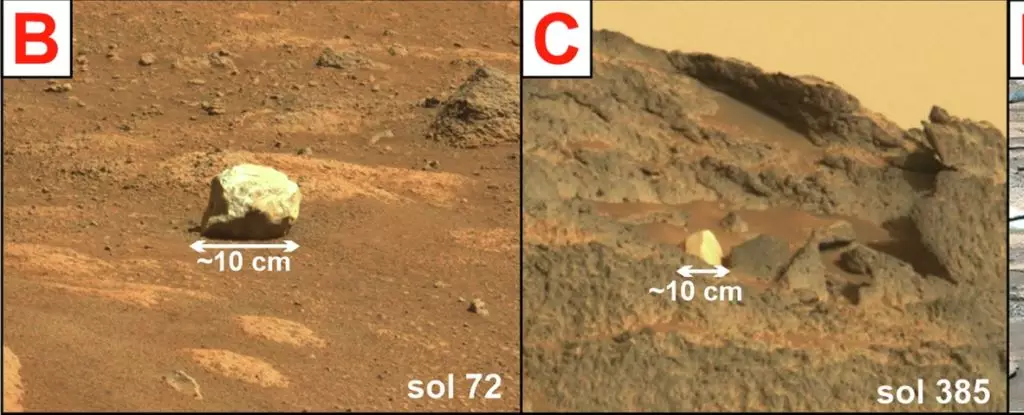Mars has long captivated human imagination, both as a potential new home for humanity and as a historical enigma harboring clues to extraterrestrial life. Recent findings in Jezero Crater are shaking up our understanding of the red planet, suggesting that it was once a dynamic environment, teeming with water and perhaps life. The mineral properties of the pale rocks found in this location challenge long-standing beliefs about Mars as a cold, arid wasteland. Instead, they paint a picture of a world that was once shady and moist—a fact that not only energizes planetary scientists but also resonates deeply with anyone fascinated by the universe’s mysteries.
Roger Wiens from Purdue University encapsulates the sentiment perfectly when he remarks on the implications of these discoveries: “These minerals form where there is intense rainfall and a warm climate or in hydrothermal systems.” The realization that these rocks are remnants of a wet and warm environment raises significant questions about Mars’ past, including whether it was ever accommodating to life in any form. The stone monuments scattered across the Martian surface now stand as historical records, containing data just waiting to be deciphered by the scientific community.
Decoding the Geological Enigma
The complexities of the Jezero Crater rocks extend beyond their appearance; they are enigmas that challenge our understanding of planetary geology. Using the state-of-the-art Laser Induced Breakdown Spectroscopy tool aboard the Perseverance rover, scientists have been unlocking the doors to Mars’ geological past. This instrument vaporizes small portions of the rocks and analyzes the emitted light to determine their elemental composition. Such techniques are crucial when investigating Martian geology from millions of miles away—it’s like interpreting a highly complex language without a clear guide.
Among the standout minerals detected is kaolinite, a clay mineral known on Earth for forming in warm, moist environments. This particular find raises eyebrows, as it suggests that there existed conditions favorable for life, obscured by the more recent desolation of the Martian landscape. Moreover, the slight variations in the Martian kaolinite suggest that weathering processes on Mars differ significantly from Earth, further complicating our understanding of their formation. If kaolinite signals past water activity, then its discovery becomes pivotal in deciphering the narrative of Mars itself.
Mysteries Within Mysteries: Spinel and Beyond
Alongside kaolinite, another intriguing mineral, spinel, has been detected within the rock formations. Spinel, an aluminum-magnesium mineral commonly associated with gemstones on Earth, further deepens the mystery. Its presence raises critical questions: how did this mineral find its way into the kaolinite-rich rocks of Mars? The possibilities are endless, ranging from exotic geological processes to ancient interactions with water that remain poorly understood.
Additionally, satellite imagery has highlighted the presence of kaolinite-rich rocks along Jezero Crater’s rim, igniting discussions about the formation processes of these minerals. If scientists can establish the origin of these rock formations, they will unlock crucial information about Mars’ hydrological history, allowing them to piece together how water may have flowed on the planet and the conditions that once prevailed.
A New Era in Planetary Science
For centuries, the narrative surrounding Mars has often been one of desolation and lack of potential for life. However, the discoveries in Jezero Crater are paving the way for a paradigm shift in planetary science. The presence of these enigmatic minerals could indicate a richer, more complex history than we have previously contemplated. “The big questions about Mars are about water,” Wiens emphasizes. Understanding how much water there was and its duration on the planet is foundational to our quest for knowledge about extraterrestrial life.
As we continue to explore and analyze these Martian gems, we inch closer to answering these profound questions. Each stone sits not merely as a relic of a distant past but as a portal to a bygone environment that might have hosted life. The investigation into Mars’ secrets is not just a scientific mission; it’s a narrative that echoes humanity’s eternal quest to understand our place in the cosmos.
The recent revelations challenge skeptics and ignite excitement, underlining the importance of Mars exploration. As rovers navigate this alien landscape, each discovery unfolds new layers of complexity, beckoning us to reconsider what we thought we knew. The future of Martian exploration holds tantalizing prospects, and each find motivates us further to investigate this captivating world that, perhaps, once mirrored our own.

